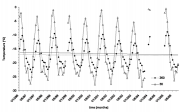Changes in Antarctic permafrost over the past 50 years
- This page is part of the topic The ice sheet in the instrumental period
Introduction
Permafrost temperatures and active layer depth are sensitive indicators of climate because they integrate different climatic factors (i.e. air temperature, seasonal snow cover, wind), which interact with each other and with the ground surface characteristics (i.e. vegetation, surface microrelief).
Permafrost temperatures and active layer thickness respond to the climate variations at different time scales because the permafrost thermal regime reacts: a) seasonally above the depth of zero annual amplitude (ZAA), b) annually at the ZAA, and c) from years to millenia at progressively greater depth. The active layer thickness responds seasonally to the climate input. Different methods are needed to monitor the permafrost thermal regime and the active layer thickness.
Changes in the last 50 years
Permafrost monitoring in Antarctica is a relatively new topic, although monitoring began in the 1960s at Signy Island in the South Orkney Islands.
More recently, new data were obtained on the thermal active layer (Cannone et al., 2006[1]; Guglielmin et al., 2007[2]). Comparing the new data with those collected at the same location four decades earlier, Cannone et al. (2006[1]) show that the active layer thickness increased around 30 cm over the period 1963–90 (a period of warming on Signy Island), but then decreased by the same amount over the period 1990–2001 when Signy Island had a series of particularly cold winters.
The site of Boulder Clay (McMurdo Sound) represents the longest and most continuous data series of permafrost and active layer temperature (Guglielmin, 2004[3]; 2006). Figure 4.43 shows the temperature recorded near the permafrost table (at a depth of 30 cm) and at the end of the borehole (360 cm deeep).
The permafrost temperature is stable at 360 cm, while at the permafrost table it shows a slight decrease of 0.1°C/year (Figure 4.43). This slight decrease (Guglielmin, In Prep.) is mainly related to the decrease of the air temperature and the decrease of the snow cover in the winter.
The decrease of ground surface temperature in relation to the decrease of surface air temperature confirms the pattern for the Dry Valleys by Doran et al. (2002[4]) for the period 1986 to 1999 at Lake Hoare.
Five km north of Boulder Clay, at the MZS station, a borehole 15.5 m deep was drilled in bedrock in 1999 and monitored manually once a year and, since 2003, automatically all year round (Guglielmin, 2006[5]). In the summer 2005/2006 a new borehole 30 m deep, just some metres away, was drilled as a template for the new IPY-ANTPAS monitoring network. The thermal profile obtained in the 30 m borehole (Figure 4.44) suggests at least two periods of cooling (around 14-15 m), following a previous period of warming. Guglielmin (2007[6], in prep) describes these quite short fluctuations of the ground surface temperature at MZS in the last 30 years.
References
- ↑ 1.0 1.1 Cannone, N., Ellis Evans, J. C., Strachan, R. and Guglielmin, M. 2006. Interactions between climate, vegetation and active layer in Maritime Antarctica, Antarctic Science, 18(3), 323-333.
- ↑ Guglielmin, M., Ellis Evans, C.J. and Cannone, N. 2007 Active layer thermal regime under different vegetation conditions in permafrost areas. A case study at Signy Island (Maritime Antarctica), Geoderma, In Press.
- ↑ Guglielmin, M. 2004. Observations on permafrost ground thermal regimes from Antarctica and the Italian Alps, and their relevance to global climate change, Global and Planetary Change, 40, 159-167.
- ↑ Doran, P.T., Priscu, J.C., Lyons, W.B., Walsh, J.E., Fountain, A.G., McKnight, D.M., Moorhead, D.L., Virginia, R.A., Wall, D.H., Clow, G.D., Fritsen, C.H., McKay, C.P. and Parsons, A.N. 2002. Antarctic climate cooling and terrestrial ecosystem response, Nature, 415, 517-520.
- ↑ Guglielmin, M. 2006. Ground surface temperature (GST), active layer, and permafrost monitoring in continental Antarctica. Permafrost and Periglacial Processes, 17, 133-143.
- ↑ Guglielmin, M. 2007, in prep. Permafrost cooling in Continental Antarctica.

